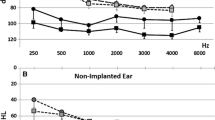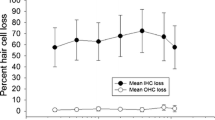Abstract
Differentiating the relative importance of the various contributors to the audiometric loss (HLTOTAL) of a given hearing impaired listener and frequency region is becoming critical as more specific treatments are being developed. The aim of the present study was to assess the relative contribution of inner (IHC) and outer hair cell (OHC) dysfunction (HLIHC and HLOHC, respectively) to the audiometric loss of patients with mild to moderate cochlear hearing loss. It was assumed that HLTOTAL = HLOHC + HLIHC (all in decibels) and that HLOHC may be estimated as the reduction in maximum cochlear gain. It is argued that the latter may be safely estimated from compression threshold shifts of cochlear input/output (I/O) curves relative to normal hearing references. I/O curves were inferred behaviorally using forward masking for 26 test frequencies in 18 hearing impaired listeners. Data suggested that the audiometric loss for six of these 26 test frequencies was consistent with pure OHC dysfunction, one was probably consistent with pure IHC dysfunction, 13 were indicative of mixed IHC and OHC dysfunction, and five were uncertain (one more was excluded from the analysis). HLOHC and HLIHC contributed on average 60 and 40 %, respectively, to the audiometric loss, but variability was large across cases. Indeed, in some cases, HLIHC was up to 63 % of HLTOTAL, even for moderate losses. The repeatability of the results is assessed using Monte Carlo simulations and potential sources of bias are discussed.








Similar content being viewed by others
References
ANSI (2004). Specification for audiometers. ANSI S3.6-2004. ANSI, New York
Bondy J, Becker S, Bruce I, Trainor L, Haykin S (2004) A novel signal-processing strategy for hearing-aid design: neurocompensation. Signal Process 84:1239–1253
Bruce IC, Sachs M, Young ED (2003) An auditory-periphery model of the effects of acoustic trauma on auditory nerve responses. J Acoust Soc Am 113:369–388
Glasberg BR, Moore BCJ (1992) Effects of envelope fluctuations on gap detection. Hear Res 64:81–92
Heinz MG, Young ED (2004) Response growth with sound level in auditory-nerve fibres after noise induced hearing loss. J Neurophysiol 91:784–795
Heinz MG, Issa JB, Young ED (2005) Auditory-nerve rate responses are inconsistent with common hypotheses for the neural correlates of loudness recruitment. J Assoc Res Otolaryngol 6:91–105
Jepsen ML, Dau T (2011) Characterizing auditory processing and perception in individual listeners with sensorineural hearing loss. J Acoust Soc Am 129:262–281
Johannesen PT, Lopez-Poveda EA (2008) Cochlear nonlinearity in normal-hearing subjects as inferred psychophysically and from distortion-product otoacoustic emissions. J Acoust Soc Am 124:2149–2163
Johannesen PT, Lopez-Poveda EA (2010) Correspondence between behavioral and individually ‘optimized’ otoacoustic emission estimates of human cochlear input/output curves. J Acoust Soc Am 127:3602–3613
Johansson MS, Arlinger SD (2003) Prevalence of hearing impairment in a population in Sweden. Int J Audiol 42:18–28
Jürgens T, Kollmeier B, Brand T, Ewert SD (2011) Assessment of auditory nonlinearity for listeners with different hearing losses using temporal masking and categorical loudness scaling. Hear Res 280:177–191
Kochkin S (2001) MarkeTrak VI: The VA and direct mail sales spark growth in hearing aid market. Hear Rev 8:16–24
Levitt H (1971) Transformed up–down methods in psychoacoustics. J Acoust Soc Am 49:466–477
Liberman MC, Dodds LW (1984) Single-neuron labelling and chronic cochlear pathology. III. Stereocilia damage and alterations of threshold tuning curves. Hear Res 16:55–74
Liberman MC, Mulroy MJ (1982) Acute and chronic effects of acoustic trauma: cochlear pathology and auditory nerve pathophysiology. In: Hamernik RP, Henderson D, Salvi R (eds) New perspectives on noise-induced hearing loss. Raven, New York, pp 105–135
Liberman MC, Dodds LW, Learson DA (1986) Structure-function correlation in noise damaged ears: a light and electronmicroscopy study. In: Salvi RJ, Henderson D, Hamernik RP, Colleti V (eds) Basic and applied aspects of noise induced hearing loss. Plenum, New York, pp 163–177
Lopez-Poveda EA, Alves-Pinto A (2008) A variant temporal masking-curve method for inferring peripheral auditory compression. J Acoust Soc Am 123:1544–1554
Lopez-Poveda EA, Johannesen PT (2009) Otoacoustic emission theories and behavioral estimates of human basilar membrane motion are mutually consistent. J Assoc Res Otolaryngol 10:511–523
Lopez-Poveda EA, Plack CJ, Meddis R (2003) Cochlear nonlinearity between 500 and 8000 Hz in listeners with normal hearing. J Acoust Soc Am 113:951–960
Lopez-Poveda EA, Plack CJ, Meddis R, Blanco JL (2005) Cochlear compression in listeners with moderate sensorineural hearing loss. Hear Res 205:172–183
Lopez-Poveda EA, Johannesen PT, Merchán MA (2009) Estimation of the degree of inner and outer hair cell dysfunction from distortion-product otoacoustic emission input/output functions. Audiolog Med 7:22–28
Marozeau J, Florentine M (2007) Loudness growth in individual listeners with hearing losses: a review. J Acoust Soc Am 122:EL81–EL87
McGill TJ, Schuknecht HF (1976) Human cochlear changes in noise induced hearing loss. Laryngoscope 86:1293–1302
Meddis R, O’Mard LP (2005) A computer model of the auditory-nerve response to forward-masking stimuli. J Acoust Soc Am 2117:3787–3798
Mills DM (2006) Determining the cause of hearing loss: differential diagnosis using a comparison of auditometric and otoacoustic emission responses. Ear Hear 27:508–525
Møller AR (2000) Hearing. Its physiology and pathophysiology. Academic, San Diego, pp 409–415
Moore BCJ (2007) Cochlear hearing loss. Physiological, psychological and technical issues, 2nd edn. Wiley, Chichester, pp 104–109
Moore BCJ, Glasberg BR (1997) A model of loudness perception applied to cochlear hearing loss. Aud Neurosci 3:289–311
Moore BCJ, Glasberg BR (2004) A revised model of loudness perception applied to cochlear hearing loss. Hear Res 188:70–88
Moore BCJ, Alcántara JI, Stone MA, Glasberg BR (1999) Use of a loudness model for hearing aid fitting: II. Hearing aids with multi-channel compression. Br J Audiol 33:157–170
Nelson DA, Schroder AC, Wojtczak M (2001) A new procedure for measuring peripheral compression in normal-hearing and hearing-impaired listeners. J Acoust Soc Am 110:2045–2064
Plack CJ, Drga V (2003) Psychophysical evidence for auditory compression at low characteristic frequencies. J Acoust Soc Am 113:1574–1586
Plack CJ, Drga V, Lopez-Poveda EA (2004) Inferred basilar-membrane response functions for listeners with mild to moderate sensorineural hearing loss. J Acoust Soc Am 115:1684–1695
Relkin EM, Turner CW (1988) A reexamination of forward masking in the auditory nerve. J Acoust Soc Am 84:584–591
Rhode WS (2007) Distortion product otoacoustic emissions and basilar membrane vibration in the 6–9 kHz region of sensitive chinchilla cochleae. J Acoust Soc Am 122:2725–2737
Rhode WS, Cooper NP (1996) Nonlinear mechanics in the apical turn of the chinchilla cochlea in vivo. Aud Neurosci 3:101–121
Robles L, Ruggero MA. (2001). Mechanics of the mammalian cochlea. Physiol. Rev. 81:1305–1352
Rosengard PS, Oxenham AJ, Braida LD (2005) Comparing different estimates of cochlear compression in listeners with normal and impaired hearing. J Acoust Soc Am 117:3028–3041
Ruggero MA, Rich NC, Recio A (1996) The effect of intense acoustic stimulation on basilar-membrane vibrations. Aud Neurosci 2:329–345
Ruggero MA, Rich NC, Recio A, Narayan SS, Robles L (1997) Basilar membrane responses to tones at the base of the chinchilla cochlea. J Acoust Soc Am 101:2151–2163
Scheidt RE, Kale S, Heinz MG (2010) Noise-induced hearing loss alters the temporal dynamics of auditory-nerve responses. Hear Res 269:23–33
Schmiedt RA (1996) Effects of aging on potassium homeostasis and the endocochlear potential in the gerbil cochlea. Hear Res 102:125–132
Stainsby TH, Moore BCJ (2006) Temporal masking curves for hearing-impaired listeners. Hear Res 218:98–111
Trautwein P, Hofstetter P, Wang J, Salvi R, Nostrant A (1996) Selective inner hair cell loss does not alter distortion product otoacoustic emissions. Hear Res 96:71–82
Wojtczak M, Oxenham AJ (2010) Pitfalls in behavioral estimates of basilar-membrane compression in humans. J Acoust Soc Am 125:270–281
Wright A, Davis A, Bredberg G, Ulehlova L, Spencer H (1987) Hair cell distribution in the normal human cochlea. Acta Otolaryngol Suppl 444:1–48
Acknowledgments
We thank Santiago Santa Cruz for his help with subject recruitment. We are grateful to the associate editor, Barbara Shinn-Cunningham, and three anonymous reviewers for their excellent suggestions on earlier versions of this manuscript. Work supported by The Oticon Foundation and by the Spanish Ministry of Innovation and Science (grants BFU2006-07536 and BFU2009-07909). Portions of this work were presented at the 33 rd Midwinter Meeting of the Association for Research in Otolaryngology, 6–10 February 2010, Anaheim, CA, USA, and at the 159th Meeting of the Acoustical Society of America, 19–23 April 2010, Baltimore, MD, USA.
Author information
Authors and Affiliations
Corresponding author
Rights and permissions
About this article
Cite this article
Lopez-Poveda, E.A., Johannesen, P.T. Behavioral Estimates of the Contribution of Inner and Outer Hair Cell Dysfunction to Individualized Audiometric Loss. JARO 13, 485–504 (2012). https://doi.org/10.1007/s10162-012-0327-2
Received:
Accepted:
Published:
Issue Date:
DOI: https://doi.org/10.1007/s10162-012-0327-2




